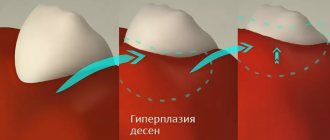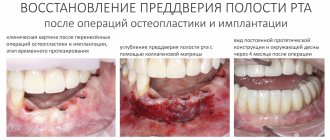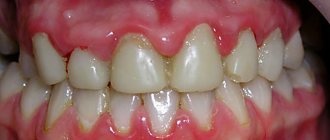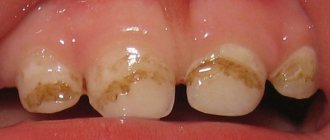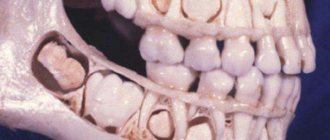Reasons for appearance
Fibroids on the gums most often appear in children under 10 years of age and adolescents. In adults, the pathology is less common. The growth of a tumor can be provoked by the following factors:
- permanent tissue injury from fillings, artificial crowns, dentures, solid food,
- stomatitis, gingivitis, periodontitis,
- taking certain medications - estrogens, anticonvulsants, cyclosporine.
In children and adolescents, the growth of fibroids is usually due to a hereditary predisposition; in adults, it is caused by injuries to the mucous membranes.
Causes of gum fibromatosis
Gingival fibromatosis is a genetically predetermined pathology characterized by a dominant type of inheritance. The main cause of the pathology is a mutation of the SOS1 gene. In addition to genetically determined fibromatosis, there is also a form of the disease that arises as a result of long-term use of certain types of medications. For example, inflammation of the gums and interdental papillae of the marginal type occurs in those who take medications for epilepsy, as well as as a result of taking immunosuppressants and calcium channel blockers.
It is also possible that fibromatosis may occur while taking hormonal contraceptives, which in some cases lead to hypertrophy of the gum tissue. Some experts associate the manifestations of fibromatosis with diseases of the endocrine system. Some hypertrophic changes in gum tissue are also characteristic of Down syndrome.
Symptoms
A benign tumor forms slowly and does not cause discomfort, so it may remain undetected for some time. If the fibroma reaches a large size and is constantly injured, the following may occur:
- swelling and redness of the gum tissue,
- discomfort and pain of varying intensity.
Constant trauma to the tumor can lead to the beginning of active growth and transition to a malignant form, infection, loosening and tooth loss. Therefore, at the first signs of fibroma, it is important to consult a doctor.
Tooth cyst
A dental cyst is a formation resembling a capsule, localized in the area of the apex of the root canal of a problem tooth, in the bone tissue of the jaw. Standard sizes
neoplasms -
from 0.5 to 2 cm
. Contents: serous exudate. The shell consists of connective tissue.
Causes of cysts:
- Dental or somatic diseases (for example, sinusitis, sinusitis).
- Chronic periodontitis - the root membrane and peri-root tissue become inflamed.
- Consequence of traumatic injuries.
Types of cysts
Dentists distinguish several types of such neoplasms. A cyst happens:
- Radicular
, located next to the root of the tooth. In the vast majority of cases, this is a consequence of inflammatory processes (for example, periodontitis). - Follicular
, adjacent to the crown. Formed when a formed but not yet erupting tooth bud becomes infected. - Paradental
. It is typical for heavy growth of the eighth molars - the tissues become inflamed, the process is difficult. - Teething
. Occurs during the period of change from primary teeth to permanent ones. - Retention cysts
are formed as a result of the outflow of secretions in the salivary glands. Typical localization is the sublingual area, mucous membranes of the cheeks, lips, and bottom of the tongue. - A keratocyst
occurs during pathological primary development of the unit. - Residual
- a consequence of complex or poor-quality tooth extraction.
Symptoms
The initial stages of cyst formation are asymptomatic. The first signs appear when the cyst has already reached a fairly large size - 0.5 cm or more. The capsule puts pressure on the tissue, and vague sensations begin, causing discomfort.
An increase in formation leads to painful sensations that do not go away after taking analgesics. When intensive formation of pus occurs in the capsule, the pain intensifies and swelling appears. Sometimes the temperature rises. Symptoms of a mature cyst are a fistula in the gum, gumboil.
Treatment of cysts
Dentists try to save the tooth, so they choose gentle techniques in each case. Deleting a unit is possible only in advanced or exceptional cases.
Therapeutic methods:
- Antiseptic treatment. In case of a cyst or granuloma, purulent exudate is pumped out of the cavity and disinfectant and anti-inflammatory drugs are administered.
- Using a laser. The beam not only removes the formation, but also has a disinfecting effect on the tissue.
Surgical methods
applicable if the cyst is located in a dangerous place, or its size is quite large (more than 2 cm, usually 3-4 centimeters). The surgeon opens the cyst, removes the pus, injects an antiseptic, and sutures it. Less commonly, the front part of the capsule or the neoplasm with the root of the tooth or its fragment is removed.
Treatment methods
Fibroids on the gums are usually removed with a laser or radio wave method. The operation lasts up to 40 minutes. If the neoplasm is large, to prevent deformation of the mucosa, the wound surface is covered with a flap formed from adjacent tissues.
If fibroma is formed due to tissue injury from a filling, crown or prosthesis, you can do without surgery. The tumor may shrink or disappear after the provoking factor is eliminated. In this case, treatment includes refilling or replacing the prosthesis.
Stages of disease development
There are three stages of gum fibromatosis:
- Initial stage. Typical manifestations are thickening of the interdental papillae. Significantly increased gum size can cover 1/3 of the dental crown in the affected area of the gum.
- Middle stage. Hypertrophied gum tissue can cover the crown part of the tooth by half.
- Difficult stage. The affected fibrous tissue covers most of the surface of the teeth.
According to the degree and direction of spread, gum fibromatosis is divided into local (the affected area does not exceed one or two teeth) and generalized.
What it is
Epulis is a tumor-like neoplasm that develops on the alveolar process of the jaw. It also has other names - epulid, supragingival, giant cell granuloma. More often it is localized in the area of incisors, canines and small molars of the upper jaw, less often the tumor is detected in the lower jaw. The growth has a round or irregular shape and a wide stalk; the size of the formation varies from 3 mm to 5 cm.
Despite the fact that such a tumor looks frightening, it practically does not cause concern to the patient, unlike, for example, a burn, with the exception of a violation of aesthetics and the sensation of a foreign body in the oral cavity. Large tumors may cause difficulty chewing and swallowing food.
If epulis is accompanied by bleeding, infection may occur, which will lead to complications.
The disease mainly affects adults, but the neoplasm can also appear in children; in the latter, it occurs during teething. Studies have shown that women are more susceptible to developing epulis than men.
Types of oral fibroids
- Dense (hard) fibroma . The formation consists of coarse connective tissue fibers containing a small number of nuclei, tightly adjacent to each other. This type of fibroma is most often located on the gums or hard palate.
- Soft fibroma . The neoplasm has a softer structure due to the formation of thin and loose fibers, the structure of which contains a large number of nuclei. This tumor is localized on the tongue and inside the oral cavity on the cheeks. In some cases, mixed neoplasms such as fibrohemangiomas or fibrolipomas may occur.
- Fibroma from irritation . This neoplasm is not a tumor and is quite common. It develops as a result of damage by mechanical or chemical means. This fibroma is located on the mucous membrane of the oral cavity and looks like a pink papule with clear boundaries. As it grows, a dense, rounded nodule appears. With constant trauma to the fibroma, lumpiness and ulceration may appear on its surface.
- Symmetrical bean-shaped fibromas with a dense consistency are usually located near three molars on the surface of the gums of the upper jaw. Such a tumor is not a true fibroma, but is an overgrowth of the gums and is accompanied by tissue scarring.
- Lobular fibroma . This neoplasm is distinguished by a lumpy surface that occurs as a result of reactive hyperplasia of the gum tissue when it is regularly injured, for example, by a removable denture.
- Fibrous epulis . This neoplasm of dense consistency is located on the gums and has slow growth.
Brief description of the disease
In addition to fibromatosis, this disease in dentistry is called hyperplasia or gingival hypertrophy.
It is characterized by the progressive, uncontrolled formation of new connective tissue cells in the gums and periodontium. From them fibril tissue is formed, which is a causative factor in the increase in the size of the gums.
According to statistical data, the disease is rare, its mechanism is not completely clear.
Signs of oral fibroma
Fibroma looks like a pink hemispherical formation, rising above the general surface of the mucous membrane and having a wide, strong base or thin stalk. Fibroids do not cause pain. Its surface is smooth and does not have any growths, unlike papilloma. As a rule, no changes in tissues and mucous membranes are observed in the area of the fibroma, but in some cases ulcerations may appear over the neoplasm. In this case, an infection develops followed by inflammation, expressed in redness, swelling and pain in the area where the fibroma is located.
A standard fibroma in the oral cavity grows slowly, almost unnoticeably. And if it is constantly exposed to trauma, then the growth of the tumor may slow down, and the tumor itself will be within the initial stage of development. It is worth considering that constant injuries lead to complications: the tumor degenerates into a malignant one.
Fibroma looks like a pink hemispherical formation, rising above the general surface of the mucous membrane and having a wide, strong base or thin stalk. Fibroids do not cause pain. Its surface is smooth and does not have any growths, unlike papilloma. As a rule, no changes in tissues and mucous membranes are observed in the area of the fibroma, but in some cases ulcerations may appear over the neoplasm. In this case, an infection develops followed by inflammation, expressed in redness, swelling and pain in the area where the fibroma is located.
A standard fibroma in the oral cavity grows slowly, almost unnoticeably. And if it is constantly exposed to trauma, then the growth of the tumor may slow down, and the tumor itself will be within the initial stage of development. It is worth considering that constant injuries lead to complications: the tumor degenerates into a malignant one.
Prognosis and prevention
When patients seek medical help in a timely manner, doctors can formulate a favorable prognosis in 75–80% of cases. The likelihood of a complete recovery of a child or adult is reduced when fibromatosis is advanced or secondary pathologies are attached to the disease.
Preventive measures are simple - patients are advised to avoid repetitive trauma to the skin, soft tissue and bones. Persons working in hazardous industries must undergo regular preventive examinations. Children and adults should eat a healthy diet and include adequate amounts of vitamins and minerals.
Complications
If a lump appears on the gum, you should immediately consult a doctor. Otherwise, pathological processes worsen, which can provoke various complications. Among them:
- infectious processes (cellulitis, abscess, likelihood of developing sepsis);
- loosening and loss of healthy teeth;
- malignant degeneration of growth tissue.
Lack of treatment for the appearance of fibroids can lead to dangerous consequences. However, with timely treatment the prognosis is favorable. As for prevention, proper oral hygiene, exclusion of traumatic factors, regular preventive examinations with a doctor, and timely treatment of identified dental diseases will help reduce the likelihood of a benign growth.
If left untreated
In almost all cases, the disease leads to the appearance of associated problems, which are considered complications in dentistry. Enlargements of the interdental papillae and gum margins lead to the formation of deep periodontal pockets.
Food debris can accumulate in them and bacteria can grow. It is impossible to empty the pockets yourself.
Such a complication very quickly degenerates into tartar, which causes inflammation of all tissues. Sometimes they detach from the tooth, which causes trauma.
The disease at stages II and III leads to bone atrophy in the affected areas of the upper jaw, osteoporosis, and destruction of the partitions between the teeth.
Loosening of the teeth, decay of the alveolar processes are observed, and dystopia develops (displacement of the teeth towards the tongue, cheeks, or rotation around its axis).
If the disease progresses in children, then there may be a delay in the change of bite and germination of permanent (molar) teeth, which in the future will adversely affect the development of the dental system.
Manifestations of the disease
The following clinical symptoms allow you to recognize gum fibromatosis:
- In the initial stages, swelling or enlargement of tissue of a tumor nature.
- On the mucous membrane you can see thickenings that gradually increase.
- Increased gum volume without signs of swelling.
- Filling interdental spaces with soft tissue.
- Overlapping of the teeth with the edges of the gums.
- Injury to overgrown areas during cleaning (this can cause bleeding and inflammation).
- Increasing intensity of tissue color (the gums become bright pink).
If you notice any signs of fibromatosis, you should immediately contact your dentist. If you ignore the problem, unpleasant complications may develop:
- decreased quality of daily hygiene with an increased risk of developing infections;
- pain when eating;
- redistribution of chewing load;
- development of periodontal diseases.
Diagnosis of oral fibroma
To determine the presence of fibroids, the dentist conducts a thorough examination of the oral cavity, palpating the tumor. If there is a suspicion of tumor growth into neighboring tissues, an ultrasound scan is prescribed. In some cases, if there are inflammatory changes or the presence of ulcers on the surface of the fibroma, a tumor biopsy is required. After removal of the fibroma, a histological analysis of its tissue is carried out in the laboratory.
A specialist needs to diagnose the cause of the neoplasm, so additional examination measures are carried out, such as:
- periodontograms;
- radiovisiography;
- orthopantomograms;
- radiography.
If the patient uses dentures, then he needs to consult with an orthopedic dentist to prevent tissue injury from this device.
Differential diagnosis of a neoplasm is carried out if the following is found in the patient’s oral cavity:
- lipoma;
- papilloma;
- epulis;
- neuroma.
If the fibroma is localized on the tongue, then first it is necessary to exclude cancer of the patient’s tongue and possible other tumors, but of a benign nature.
Varieties of epulis
Conventionally, there are 3 types of epulis:
- Fibrous. The neoplasm is dense, the basis is coarse fibrous tissue. Characterized by slow growth. There is no pain or bleeding.
- Angiomatous. The tumor contains a large number of blood vessels and is localized mainly in the lateral parts of the jaw. With this form of the disease, bleeding is observed even with slight pressure, for example, with a toothbrush or food. When pressed, the tumor is painless and has a soft consistency.
- Giant cell. The tumor can reach large sizes, displacing teeth that are located in the epulis growth zone. The mucous membrane of the epulis is bluish-red in color. On palpation, the neoplasm is painless, but may bleed moderately if injured.
Depending on the nature of the process, epulis can be benign or malignant. In the first case, the neoplasm is characterized by slow development and, as mentioned above, in most cases does not cause pain. The tumor size in this case rarely exceeds 10–20 mm. When the process becomes malignant, rapid tissue growth is observed. In this case, the process is often accompanied by pain, bleeding gums and affects the root canals of neighboring teeth.
Mechanism of development of hyperplasia
The mechanism of development of the hypertrophic process remains not fully understood. However, scientists have discovered that the pathogenesis of the disease is influenced by impaired calcium transport. This leads to increased production of collagenase, which causes the gums to grow. Hyperplasia develops gradually, so patients do not pay attention to it right away.
Stages of the disease:
- First: the tissue covers a third of the tooth, there are no signs of an inflammatory process.
- Second: covers half of the tooth, bleeding may occur, especially with mechanical impact.
- Third: overlap from two-thirds to the entire crown, sometimes even the cutting edge and chewing surface are covered with soft tissue, granulations are visible over the entire surface.
